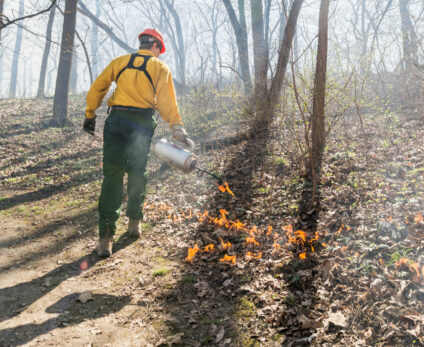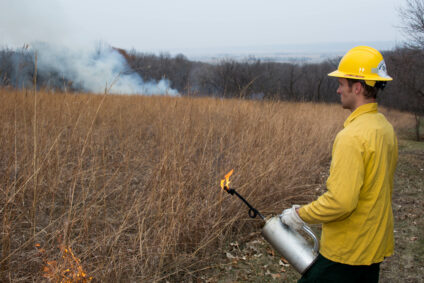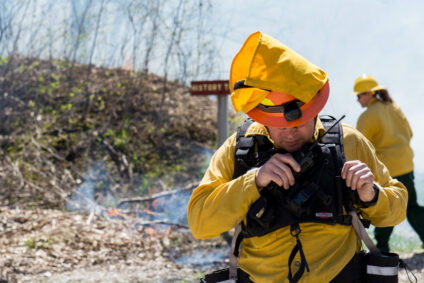prescribed fire
We conduct annual prescribed burns in order to help reduce the density of trees and woody shrubs, as well as increase the grassy component of our native vegetation.
LEARN MORE ABOUT OUR OTHER CONSERVATION EFFORTS
WHAT TO EXPECT DURING PRESCRIBED FIRE SEASON
In the last lingering days of fall, or in the early, brisk days of spring, you may spy a plume of smoke or catch a whiff of something burning coming from the woods. This signals a burn day. It also means that Fontenelle Forest is fulfilling its commitment to stewardship by doing the most compassionate action we can to improve our natural areas – prescribed fire.
Oak savannas and oak woodlands are the vibrant and verdant communities that once dominated the region. Today, the reality is that much of the Midwest is facing an epidemic of ecological decline. One can observe this decline by examining the decreasing biodiversity of the native flora and fauna to our region, and the increasing abundance of woody shrubs and trees, both native and non-native. With each year that passes, the lack of historical disturbances, like fire and grazing, result in a system that looks less and less like the functional, precolonial version. 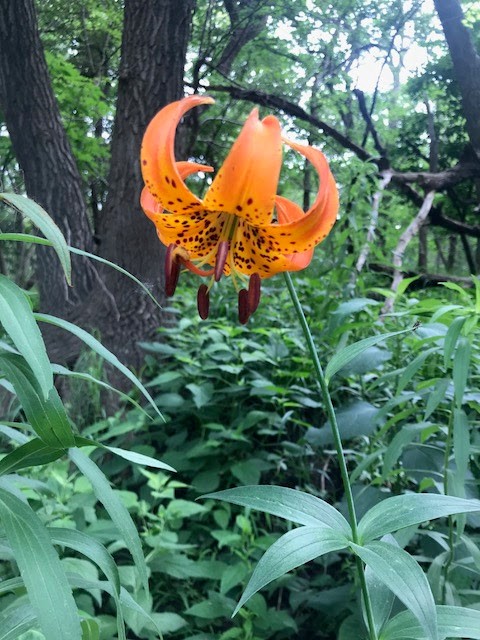
Committing to oak savanna restoration allows for increased biodiversity and a greater number of symbiotic relationships to be restored. The first step in returning the community to its former glory is to restructure our landscape to resemble that of precolonial times, and to implement or imitate the same cycles that once brought balance to the system.
Prescribed fire is the most effective and cost-efficient tool we have to enhance the health of our oak woodlands and savannas. The majority of our plants have evolved to be aided by disturbance. By implementing fire on the landscape, we are able to eliminate invasive species, bring balance to overpopulated species, and promote the diverse native vegetation that once blossomed across our rolling landscape. This expansive biodiversity found in our forbs and grasses serves as the bedrock of the ecosystem and can only truly thrive in a fire environment.
Several native species are exclusively detected in areas where there is fire on the landscape. Turk’s Cap Lilies, Lilium canadense, is one such species. Their populations are known to decline in fire suppressed areas.
A prime example of fire adaptation is our keystone species, the bur oak, which has oil-coated leaves that are especially flammable. These reactive leaves increase the likelihood of active fire around the base and surrounding area of bur oaks. Meanwhile, their bark and their acorns are both designed to withstand the heat of ground fire exceptionally well. This allows the other less fire-adapted woody plants to be killed or damaged, reducing the competition for resources. Therefore, the bur oak acorns can become viable oak sprouts which have ample room and sunlight to grow.
Learn more about oak restoration here:
Habitat Restoration |
BUR OAKS AND FIRE INFORMATION |
OAK WOODLAND RESTORATION |
URBAN PRESCRIBED FIRE |
Why prescribed fire?
Fire is the best tool in our toolbox to care for the health of the ecosystem. Prescribed fire is a long-established practice by humans on the landscape. Many Native Americans recognized the benefits of fire to the landscape and their lives, and consciously ignited the land around them. Lightning strikes or other natural ignitions also contributed to the frequency of fire in the system. The average frequency of fire on the landscape was between three to seven years. Most often, fire would have occurred in the fall. However, land managers will increase the frequency and vary the timing of fire to accomplish differing objectives for the vegetative structure, composition, and condition of the given area.
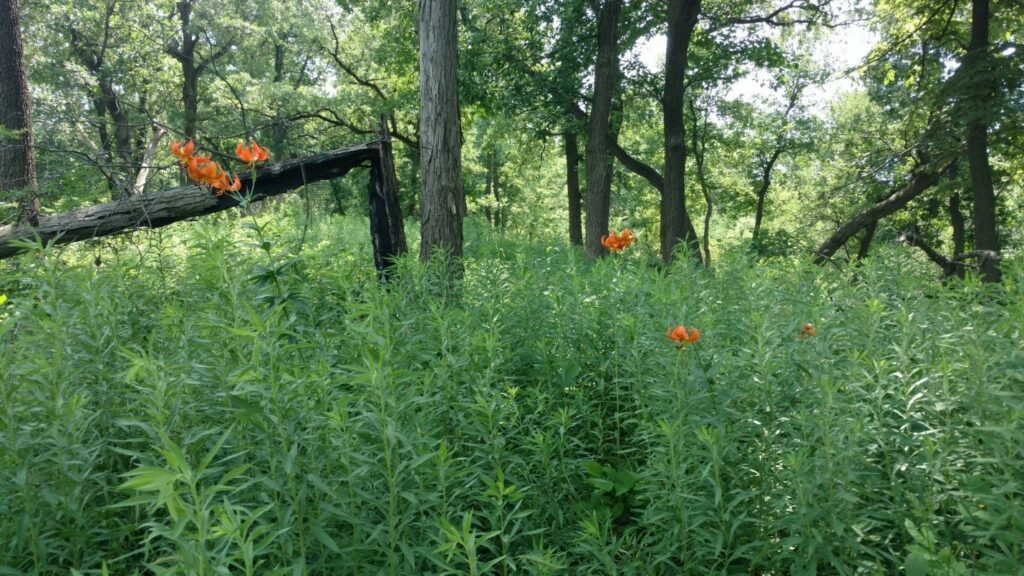
For example, at Fontenelle Forest and Neale Woods, we are conducting annual prescribed fires in order to help reduce the density of trees and woody shrubs, as well as increase the grass component of our native vegetation. Selectively identifying what constitutes a successful burn day always refers to the specific burn objectives for an individual unit.
Ideal Burn Conditions
The specific conditions needed to burn take the following into account: temperature, humidity, wind speeds, and directions. These metrics are also referenced against seasonal conditions that contribute to the collective moisture contained in the native vegetation. A typical prescription for a burn day at Fontenelle Forest is one with highs between 55-85 degrees Fahrenheit and a relative humidity of below 40%. Ideally, we would like moderate winds to help push fire across less receptive fuels. Burn plans for each unit identify required burn directions in order to keep smoke from settling in surrounding neighborhoods or vulnerable communities. Staff also will reference fuel moisture maps, provided by the National Oceanic and Atmospheric Administration (NOAA – also known as the National Weather Service), to identify how seasonal precipitation will affect the receptivity of fuels to fire. We may also request a spot weather forecast to predict the specific fire weather conditions for our burn unit. All these metrics are constantly evaluated leading up to, throughout the duration of, and following the prescribed fire.
Burn Safety
Safety is always our number one priority. We put countless hours of work into our training, planning, and on-the-ground preparation for every single burn. Every single member of our burn crew is qualified and certified through the National Wildfire Coordinating Group (NWCG). Many of our core fire staff also sacrifice and serve as wildland firefighters across the county. This allows us ample knowledge and experience to implement safe and effective prescribed fires on the landscape. We recognize the unique challenges of working in a wildland urban interface and we are strongly committed to maintaining the highest national standards of excellence in conducting prescribed fire operations. We are further committed to sharing this knowledge base and expanding the community of informed, qualified, and competent fire practitioners across the region.
To learn more about prescribed fire at Fontenelle Forest and how you can participate or contribute to prescribed fire operations in our community, email Biologist, Michaela Johnson.
Additional Resources:
NWCG Training



